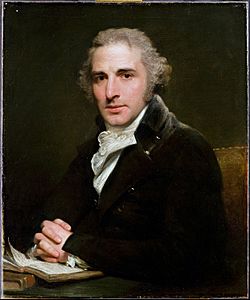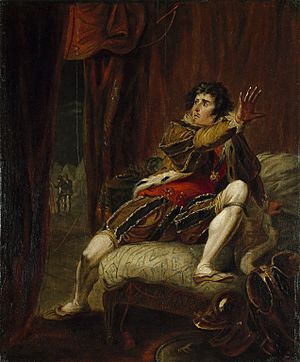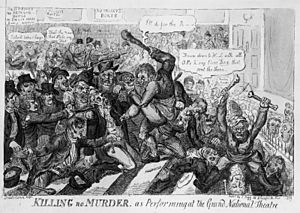John Philip Kemble facts for kids
Quick facts for kids
John Philip Kemble
|
|
|---|---|

John Philip Kemble by Sir William Beechey, 1798
|
|
| Born | 1 February 1757 Prescot, Lancashire, England
|
| Died | 26 February 1823 (aged 66) Lausanne, Switzerland
|
| Occupation | Actor-manager |
| Years active | 1761–1817 |
| Spouse(s) | Priscilla Hopkins Brereton |
| Parent(s) | Roger Kemble Sarah Ward |
| Relatives | Sarah Siddons (sister) Charles Kemble (brother) Stephen Kemble (brother) Ann Hatton (sister) Elizabeth Whitlock (sister) |
| Signature | |
 |
|

John Philip Kemble (born February 1, 1757 – died February 26, 1823) was a famous British actor. He came from a family of performers. His father, Roger Kemble, managed a traveling acting group. John's older sister, Sarah Siddons, became very famous alongside him on stage. His other brothers and sisters, Charles Kemble, Stephen Kemble, Ann Hatton, and Elizabeth Whitlock, were also successful actors.
Contents
Early Life and First Roles
John Philip Kemble was the second child of Roger Kemble. His father managed a theater company called the Warwickshire Company of Comedians. John was born in Prescot, Lancashire, England.
Because his mother was Catholic, John went to a Catholic school called Sedgley Park seminary. He also studied in Douai, France. His family hoped he would become a priest. However, after four years, he realized he did not want to be a priest.
He returned to England and joined an acting group. His first performance was on January 8, 1776, in a play called Theodosius. In 1778, Kemble joined another acting company in York. He played important roles like Captain Plume and Macbeth. In 1781, he got a special acting job in Dublin. He first appeared there as Hamlet on November 2. He also did very well as Raymond in The Count of Narbonne.
Becoming a Star at Drury Lane
John Kemble slowly became known as a careful and skilled actor. His sister Sarah's fame also helped him. This led to him getting a job at the Theatre Royal, Drury Lane in London. He first performed there on September 30, 1783, as Hamlet. Critics found his Hamlet interesting, even if the public wasn't immediately thrilled.
On March 31, 1785, he played Macbeth. He performed with his sister, Sarah Siddons, who was also very popular. Together, they became two of the most famous actors of their time. They first acted together at Drury Lane on November 22, 1783. They played characters in plays like The Gamester and Shakespeare's King John.
In the next few years, they continued to act together in many plays. These included The Carmelite and A Maid of Honor. They also played Othello and Desdemona. Between 1785 and 1787, Kemble took on many different roles. His performance as Mentevole in Julia was especially powerful.
Managing the Theater
In December 1787, John Kemble married Priscilla Hopkins Brereton. She was also an actress and had been married before. In 1788, Kemble became the manager of the Drury Lane theatre. This job allowed him to choose how characters looked on stage. He could dress them in ways that fit his ideas, rather than just following old traditions. He also tried out many different roles.
One of his most famous roles was Coriolanus in his own version of Shakespeare's Coriolanus. This character fit him perfectly. People said he played it so well that it even changed his own manners and speech. His tall height, noble face, and serious manner were perfect for Roman characters in Shakespeare's plays. When he had to show a character's growing emotions, his acting became very strong and impressive.

Kemble was known for his careful study of each character. He planned every small detail of his performances. He was excellent at speaking clearly and with great rhythm. However, he found it harder to show very strong or sudden emotions. He was amazing in plays like Coriolanus and Cato. Some people even thought he was better than other famous actors like Garrick and Kean in the role of Macbeth.
He was considered less strong in other Shakespearean roles. These included Shylock and Richard III. However, he was still very good as Lear (though he preferred a version of the play with a happy ending) and Hamlet. He also regularly put on performances of Cymbeline starting in 1801.
Because of problems with the owner of Drury Lane, Richard Brinsley Sheridan, Kemble left his manager job. He came back for a short time in 1800 but finally left for good in 1802.
The Forged Play
In 1795, Kemble was asked to perform in a play called Vortigern and Rowena. It was said to be a newly found play by William Shakespeare. But it was actually a fake, created by a teenager named William Henry Ireland. Ireland had convinced Richard Brinsley Sheridan to produce it.
Kemble later said he doubted the play was real. He suggested it should open on April Fool's Day. But Ireland's father disagreed, so the play opened on April 2. There was a lot of talk in the newspapers about whether the play was real or not. During the performance, the first three acts went smoothly. But later in the play, Kemble used a line from the play to share his own thoughts. He repeated Vortigern's line, "and when this solemn mockery is o'er." This made some people in the audience boo.
New Beginnings at Covent Garden
In 1803, John Kemble became the manager of the Theatre Royal, Covent Garden. He had bought a part of the theater for £23,000. Sadly, the theater burned down on September 20, 1808. When the new theater opened in 1809, the ticket prices were raised. This led to the Old Price Riots. These protests stopped performances for three months.
The fire had almost ruined Kemble financially. He was saved by a very kind loan of £10,000 from the Duke of Northumberland. This loan was later changed into a gift. John Kemble gave his last performance on stage as Coriolanus on June 23, 1817.
Later Life and Legacy
John Kemble's decision to retire was likely sped up by the growing popularity of another actor, Edmund Kean. Kemble spent his last years mostly living outside England. He passed away in Lausanne, Switzerland, on February 26, 1823.
Even though Kemble was buried in Lausanne, there is a life-size marble statue of him in Westminster Abbey in London. It stands near the statue of his sister, Sarah Siddons. This statue was finished by Thomas Denman after the death of the sculptor John Flaxman.
A street in his hometown of Prescot is also named after him.
Tributes to a Great Actor
A sculpture of Kemble made in 1814 by John Gibson can be seen at the National Portrait Gallery, London.
Another sculpture of Kemble by Charles Molloy Westmacott was shown at the Royal Academy, London in 1822.
The writer Letitia Elizabeth Landon wrote a poem about Kemble in 1834. It was based on a painting of him in costume by Thomas Lawrence.



